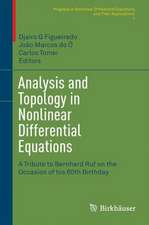Geography of Order and Chaos in Mechanics: Investigations of Quasi-Integrable Systems with Analytical, Numerical, and Graphical Tools: Progress in Mathematical Physics, cartea 64
Autor Bruno Cordanien Limba Engleză Hardback – 17 sep 2012
Geography of Order and Chaos in Mechanics will be a valuable resource for professional researchers and certain advanced undergraduate students in mathematics and physics, but mostly will be an exceptional reference for Ph.D. students with an interest in perturbation theory.
| Toate formatele și edițiile | Preț | Express |
|---|---|---|
| Paperback (1) | 391.40 lei 6-8 săpt. | |
| Springer – 15 oct 2014 | 391.40 lei 6-8 săpt. | |
| Hardback (1) | 384.22 lei 39-44 zile | |
| Springer – 17 sep 2012 | 384.22 lei 39-44 zile |
Din seria Progress in Mathematical Physics
-
 Preț: 377.18 lei
Preț: 377.18 lei -
 Preț: 398.92 lei
Preț: 398.92 lei -
 Preț: 395.25 lei
Preț: 395.25 lei -
 Preț: 391.02 lei
Preț: 391.02 lei -
 Preț: 396.62 lei
Preț: 396.62 lei -
 Preț: 396.62 lei
Preț: 396.62 lei - 20%
 Preț: 481.50 lei
Preț: 481.50 lei -
 Preț: 399.29 lei
Preț: 399.29 lei -
 Preț: 391.02 lei
Preț: 391.02 lei -
 Preț: 381.98 lei
Preț: 381.98 lei - 18%
 Preț: 1239.85 lei
Preț: 1239.85 lei - 18%
 Preț: 1118.93 lei
Preț: 1118.93 lei - 15%
 Preț: 649.87 lei
Preț: 649.87 lei - 15%
 Preț: 575.10 lei
Preț: 575.10 lei - 18%
 Preț: 786.18 lei
Preț: 786.18 lei - 15%
 Preț: 656.10 lei
Preț: 656.10 lei -
 Preț: 395.25 lei
Preț: 395.25 lei -
 Preț: 382.18 lei
Preț: 382.18 lei - 15%
 Preț: 648.56 lei
Preț: 648.56 lei - 15%
 Preț: 649.06 lei
Preț: 649.06 lei - 15%
 Preț: 645.60 lei
Preț: 645.60 lei -
 Preț: 392.21 lei
Preț: 392.21 lei - 15%
 Preț: 595.86 lei
Preț: 595.86 lei -
 Preț: 409.13 lei
Preț: 409.13 lei - 15%
 Preț: 690.62 lei
Preț: 690.62 lei - 15%
 Preț: 704.69 lei
Preț: 704.69 lei - 15%
 Preț: 654.43 lei
Preț: 654.43 lei - 15%
 Preț: 646.30 lei
Preț: 646.30 lei -
 Preț: 398.35 lei
Preț: 398.35 lei -
 Preț: 402.76 lei
Preț: 402.76 lei - 15%
 Preț: 588.50 lei
Preț: 588.50 lei -
 Preț: 388.72 lei
Preț: 388.72 lei - 18%
 Preț: 781.62 lei
Preț: 781.62 lei -
 Preț: 408.16 lei
Preț: 408.16 lei -
 Preț: 391.79 lei
Preț: 391.79 lei
Preț: 384.22 lei
Nou
Puncte Express: 576
Preț estimativ în valută:
73.52€ • 78.62$ • 61.30£
73.52€ • 78.62$ • 61.30£
Carte tipărită la comandă
Livrare economică 14-19 aprilie
Preluare comenzi: 021 569.72.76
Specificații
ISBN-13: 9780817683696
ISBN-10: 0817683690
Pagini: 334
Ilustrații: XVIII, 334 p.
Dimensiuni: 155 x 235 x 23 mm
Greutate: 0.61 kg
Ediția:2013
Editura: Springer
Colecția Birkhäuser
Seria Progress in Mathematical Physics
Locul publicării:New York, NY, United States
ISBN-10: 0817683690
Pagini: 334
Ilustrații: XVIII, 334 p.
Dimensiuni: 155 x 235 x 23 mm
Greutate: 0.61 kg
Ediția:2013
Editura: Springer
Colecția Birkhäuser
Seria Progress in Mathematical Physics
Locul publicării:New York, NY, United States
Public țintă
ResearchCuprins
Preface.- List of Figures.- 1 Introductory Survey.- 2 Analytical Mechanics and Integrable Systems.- 3 Perturbation Theory.- 4 Numerical Tools I: ODE Integration.- 5 Numerical Tools II: Detecting Order, Chaos, and Resonances.- 6 The Kepler Problem.- 7 The KEPLER Program.- 8 Some Perturbed Keplerian Systems.- 9 The Multi-Body Gravitational Problem.- Bibliography.- Index.
Textul de pe ultima copertă
This original monograph aims to explore the dynamics in the particular but very important and significant case of quasi-integrable Hamiltonian systems, or integrable systems slightly perturbed by other forces. With both analytic and numerical methods, the book studies several of these systems—including for example the hydrogen atom or the solar system, with the associated Arnold web—through modern tools such as the frequency-modified fourier transform, wavelets, and the frequency-modulation indicator. Meanwhile, it draws heavily on the more standard KAM and Nekhoroshev theorems.
Geography of Order and Chaos in Mechanics contains many figures that illuminate its concepts in novel ways, but perhaps its most useful feature is its inclusion of software to reproduce the various numerical experiments. The graphical user interfaces of five supplied MATLAB programs allows readers without any knowledge of computer programming to visualize and experiment with the distribution of order, chaos and resonances in various Hamiltonian systems.
This monograph will be a valuable resource for professional researchers and certain advanced undergraduate students in mathematics and physics, but mostly will be an exceptional reference for Ph.D. students with an interest in perturbation theory.
Geography of Order and Chaos in Mechanics contains many figures that illuminate its concepts in novel ways, but perhaps its most useful feature is its inclusion of software to reproduce the various numerical experiments. The graphical user interfaces of five supplied MATLAB programs allows readers without any knowledge of computer programming to visualize and experiment with the distribution of order, chaos and resonances in various Hamiltonian systems.
This monograph will be a valuable resource for professional researchers and certain advanced undergraduate students in mathematics and physics, but mostly will be an exceptional reference for Ph.D. students with an interest in perturbation theory.
Caracteristici
Offers a unique approach to the dynamics of quasi-integrable Hamiltonian systems Provides a rare opportunity for readers to experiment with and fully conceptualize recent numerical tools via customized MATLAB applications Gives a rigorous but clean and uncluttered presentation of perturbaton theory, including clear proofs of the KAM and Nekhoroshev theorems Fully describes new, sophisticated techniques for reducing two paradigmatic problems the field to normal forms? Includes supplementary material: sn.pub/extras

















